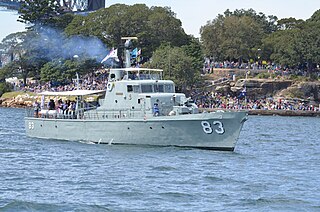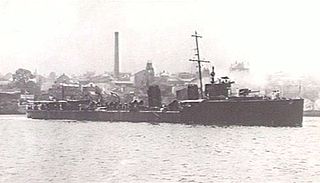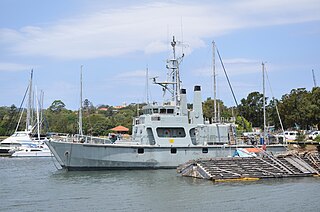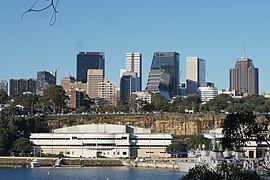
The Royal Australian Navy (RAN) is the naval force of the Australian Defence Force (ADF). The professional head of the RAN is Chief of Navy (CN) Vice Admiral Mark Hammond AM, RAN. CN is also jointly responsible to the Minister of Defence (MINDEF) and the Chief of Defence Force (CDF). The Department of Defence as part of the Australian Public Service administers the ADF.

The Clearance Diving Branch is the specialist diving unit of the Royal Australian Navy (RAN) whose versatile role covers all spheres of military diving, and includes explosive ordnance disposal and maritime counter-terrorism. The Branch has evolved from traditional maritime diving, and explosive ordnance disposal, to include a special operations focus.

HMAS Advance was an Attack-class patrol boat of the Royal Australian Navy (RAN). Constructed during 1967 and commissioned into the RAN in 1968, Advance operated from Darwin and patrolled northern Australian waters.

HMPNGS Lakekamu is Balikpapan-class landing craft heavy (LCH) operated by the Maritime Operations Element of the Papua New Guinea Defence Force (PNGDF). The vessel was one of eight built for the Royal Australian Navy (RAN) in the 1970s, and was commissioned into the RAN as HMAS Labuan in March 1973. Labuan was decommissioned in November 2014. She was transferred to the PNGDF for use as a training ship and was commissioned as HMPNGS Lakekamu in December 2014.
The Royal Australian Navy, although a significant force in the Asia-Pacific region, is nonetheless classed as a medium-sized navy. Its fleet is based around two main types of surface combatant, with limited global deployment and air power capability. However, in 2009, a white paper, Defending Australia in the Asia Pacific Century: Force 2030, was produced by the Australian government which set out a programme of defence spending that will see significant improvements to the RAN's fleet and capabilities.

The Huon-class minehunter coastal (MHC) ships are a group of minehunters built for the Royal Australian Navy (RAN). Following problems with the Bay-class minehunters, a request for tender was issued in 1993 for a class of six coastal minehunters under the project designation SEA 1555. The tender was awarded in 1994 to the partnership of Australian Defence Industries (ADI) and Intermarine SpA, which was offering a variant of the Italian Gaeta-class minehunter.

HMAS Huon (D50), named after the Huon River, was a River-class torpedo-boat destroyer of the Royal Australian Navy (RAN). Originally to be named after the River Derwent, the ship was renamed before her 1914 launch because of a naming conflict with a Royal Navy vessel.

HMAS Huon, named for the Huon River, is the lead ship of the Huon class of minehunters operated by the Royal Australian Navy (RAN). The first of six ships built by a joint partnership of Australian Defence Industries (ADI) and Intermarine SpA, Huon's hull was fabricated at Intermarine's Italian shipyard, then freighted to ADI facilities at Newcastle for completion. She entered service in 1999.

HMAS Kuttabul is a Royal Australian Navy (RAN) base located in Potts Point in Sydney, New South Wales, Australia. Kuttabul provides administrative, training, logistics and accommodation support to naval personnel assigned to the various facilities that form Fleet Base East, the main operational navy base on the east coast of Australia. A part of Fleet Base East itself, Kuttabul occupies several buildings in the Sydney suburb of Potts Point and in the immediately adjacent Garden Island dockyard. It also supports navy personnel posted to other locations throughout the greater Sydney region.

Fleet Base East is a Royal Australian Navy (RAN) major fleet base that comprises several naval establishments and facilities clustered around Sydney Harbour, centred on HMAS Kuttabul. Fleet Base East extends beyond the borders of Kuttabul and includes the commercially-operated dockyard at Garden Island, and adjacent wharf facilities at nearby Woolloomooloo, east of the Sydney central business district in New South Wales, Australia. Fleet Base East is one of two major facilities of the RAN, the other facility being Fleet Base West. The fleet operates in the Pacific Ocean.

The Belgian Navy, officially the Naval Component of the Belgian Armed Forces, is the naval service of Belgium.

MSA Brolga (1102) was a minesweeper operated by the Royal Australian Navy (RAN) between 1988 and 2003. Launched in 1975 by Australian Shipbuilding Industries, the ship was designed for the Department of Transport as the lighthouse tender Lumen. Originally operating as a supply vessel for lighthouses around northern Queensland and the Torres Strait, the transition in lighthouse lights from acetylene gas to solar power meant there was less demand for the vessel, and by 1988, the Department of Transport was looking to sell the ship.

The history of the Royal Australian Navy traces the development of the Royal Australian Navy (RAN) from the colonisation of Australia by the British in 1788. Until 1859, vessels of the Royal Navy made frequent trips to the new colonies. In 1859, the Australia Squadron was formed as a separate squadron and remained in Australia until 1913. Until Federation, five of the six Australian colonies operated their own colonial naval force, which formed on 1 March 1901 the Australian Navy's (AN) Commonwealth Naval Force which received Royal patronage in July 1911 and was from that time referred to as Royal Australian Navy (RAN). On 4 October 1913 the new replacement fleet for the foundation fleet of 1901 steamed through Sydney Heads for the first time.

The Bay-class Minehunter Inshores were a class of catamaran-hull mine warfare vessels operating with the Royal Australian Navy from 1986. Also referred to as the MHCAT, the class was an attempt to produce a locally designed inshore mine warfare vessel. Two prototype ships were ordered in 1981, with the first ship, Rushcutter, commissioned in November 1986. The two ships experienced delays in construction, and the RAN resorted to acquiring six minesweeper auxiliaries (MSA) under the Craft of Opportunity Program to provide an interim mine-warfare capability, while also keeping Ton-class minesweeper HMAS Curlew in service until 1990, well beyond her intended decommissioning date. The ships did not enter service until 1993, due to problems with the sonar.

HMAS Norman, named for the Norman River in Queensland, is the third Huon-class minehunter to serve in the Royal Australian Navy (RAN). Built by a joint partnership between Australian Defence Industries (ADI) and Intermarine SpA, Norman was constructed at ADI's Newcastle shipyard, and entered service in 2000.

HMAS Hawkesbury, named for the Hawkesbury River, is the second Huon-class minehunter to have been built for the Royal Australian Navy (RAN). Built by a joint partnership between Australian Defence Industries (ADI) and Intermarine SpA, Hawkesbury was constructed at ADI's Newcastle shipyard, and entered service in 2000.

HMAS Yarra is the sixth Huon-class minehunter to have been built for the Royal Australian Navy (RAN) and the fourth warship to be named after the Yarra River in Victoria. Built by a joint partnership between Australian Defence Industries (ADI) and Intermarine SpA, Yarra was constructed at ADI's Newcastle shipyard, and entered service in 2003.

The Lerici class is a class of minehunters constructed by Intermarine SpA and owned and operated by the Italian Navy. The class incorporates two subclasses: the first four ships are referred to specifically as the first series of the Lerici class, while eight more ships produced to a slightly modified design are known as "second series Lericis" or as the Gaeta class.

Seahorse Mercator is a navigational training vessel operated by Defence Maritime Services under contract to the Royal Australian Navy (RAN). She is a modified version of the Pacific-class patrol boat design and is based at HMAS Waterhen in Sydney.





















